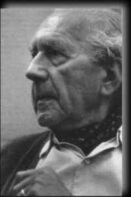Alfred Sohn-Rethel (1899–1990), who in his major work Intellectual and Manual Labour, completed in 1951 but published two decades later, argued that the ‘real abstraction’ of exchange is the true origin of abstract (mathematical) thinking and, through that, of scientific thought more generally. Thus, the evolution of money and that of science run parallel to each other, both beginning in archaic/classical Greece with the invention of coinage c.680. This thesis, of ‘the secret identity of commodity form and thought form’, remains unique in being the only major attempt to integrate epistemology into historical materialism via Kant, or the problem Kant poses in theCritique of Pure Reason, and Marx’s theory of value. (For later development on broadly similar lines see Richard Seaford,Money and the Greek Mind (2004) and R. W. Müller,Geld und Geist (1977))
Born into a family of painters who were determined that he at least shouldn’t become one, so he could contribute to their upkeep financially, Sohn-Rethel instead started reading Bebel and Marx when he was still in school. He asked for the three volumes of Capital as a Christmas present when he was about to turn 17. A few years later, at university in Heidelberg, he immersed himself in the first sixty pages of Marx’s book for a whole year and a half, riveted by the theory of value.
Sohn-Rethel spent part of his adolescent years in the family of the Dusseldorf steel magnate Ernst Poensgen. It was Poensgen who gave him those volumes of Capital. And it was this family connection that explains how (with no special enthusiasm) he landed an extraordinary job ‘in the lion’s cave’, on the eve of the Nazi seizure of power, in 1931. Poensgen got him a job at the MWT (Mitteleuropäischen Wirtschaftstag), a lobby group for the leading German industrial enterprises, banks and business associations. The exceptional quality of Sohn-Rethel’s Economy and Class Structure of German Fascism, written sporadically over many years (and only published in 1973) stems from the fact that it was grounded in the inside knowledge he gained as a research employee of the MWT. Years later he described this period as that of a ‘Marxist in the cave of the capitalists’. In Oskar Negt’s words, it was like ‘watching capitalism in its bedroom, in a social space protected from the rest of the world, where intimate fantasies reign, and the secret wishes and pathologies of the amassing of surplus-value originate’.
When Sohn-Rethel was arrested by the Gestapo in the winter of 1933, during a raid in Berlin’s artist colony where he lived, he was released after just 2 days. In 1936, he left Berlin for Switzerland where he wanted to work with the Frankfurt School but couldn’t because of Horkheimer’s opposition. By 1937 he relocated to Britain where he spent the next 3½ decades. In England, he said later in an interview, he hardly ever came out of his room! In 1951 Lawrence & Wishart turned down the manuscript of Intellectual and Manual Labour, discouraged by its lack of orthodoxy. He returned to Germany in 1972 where a translation of this work had just been published (with considerable success) and where his book on fascism would appear the following year.
The first six chapters of Economy & Class Structure of German Fascism are simply stunning. Nothing like them have been written in the Left tradition, because they are based on a blending of Sohn-Rethel’s firsthand experience in a key location of German big business (the MWT) with an innovative theoretical analysis of the dilemmas facing capital in Germany towards the end of the twenties. The Left almost never writes about capital ‘from the inside’ but Sohn-Rethel certainly did. Access to innumerable conversations, discussions, memos, etc. and firsthand knowledge of the tensions within German big business made him acutely aware of the clash between two very different ‘factions of capital’ which he chose to represent, emblematically, by the difference between Siemens with its horror at the thought that German firms would be forced to abdicate world markets if Hitler came to power and the bankrupt heavy industries in the Harzburg Front who were solidly behind the Nazis and were their main financiers. Siemens depended on huge infrastructure contracts that involved fierce bidding by international consortia and had no interest either in ‘autarchy’ or in the further disruption of international markets, many of these in regions like China and South America. The iron & steel industry, on the other hand, had suffered a massive erosion of profitability thanks to the new ‘production economy of fixed costs’, with huge investments in fixed capital generating mounting overheads (interest, depreciation, etc.) that could no longer be adjusted downward when demand plummeted.
MWT, Sohn-Rethel explains, had the near-impossible task of reconciling these divisions within German capital by forging a platform ‘upon which a new grouping of industrial interests could emerge, a grouping which would amount to a concentration of all the decisive elements of German monopoly capital’. Max Hahn, Sohn-Rethel’s boss, ‘maintained close relations with most of these groupings’, and in any case between the two camps (the Brüning camp, supported by Siemens and the export firms, and the hawks of the Harzburg Front) there were both enterprises too diverse in nature to take a clear stand at this stage (I.G. Farben) as well as capitalists like Baron von Wilmowski who eventually died in a concentration camp. Von Wilmowski was head of the financially independent, family-controlled Krupp concern as well as chairman of MWT. About him Sohn-Rethel writes: he had ‘only the deepest revulsion for Hitler, Hitlerism and the persecution of the Jews’. The economic dimensions of fascism have scarcely ever been described with such concise lucidity.
by Jairus Banaji

